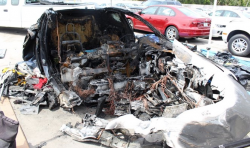— According to the National Transportation Safety Board (NTSB), Tesla Model S driver Barrett Riley and his front seat passenger Edgar Monserratt Martinez were killed because Riley lost control of the car as a result of excessive speed.
In a final report from safety investigators, the probable cause of the crash and fire was a reported speed of 116 mph on a 30 mph curve with an advised speed limit of 25 mph. And contributing to the fatal injuries was the post-crash fire that originated from the Model S lithium-ion battery.
The car was purchased in December 2014 and was owned by the driver’s family through a limited liability company. But his family says they gave the car to Riley at the end of 2017, making him the primary driver. NTSB says the car had two unrepaired recalls, but neither was a factor in the crash.
According to the Florida Department of Highway Safety and Motor Vehicles, Riley was cited on March 3, 2018, for driving 112 mph in a 50-mph speed limit zone. Riley's father contacted Tesla about any speed devices could be put on the car, and a Tesla facility placed the vehicle in "loaner" mode that restricted the top speed to 85 mph.
However, the Model S was later brought in for service and employees at Tesla removed the loaner mode "at the request of the driver, who was empowered to make service decisions for the vehicle."
The crash occurred on May 8, 2018, when the 2014 Tesla Model S P85D was traveling south on Seabreeze Boulevard in Fort Lauderdale, Florida. The car was traveling 116 mph three seconds before the crash and 109 mph two seconds before impact.
According to witnesses the car traveled into the left lane to pass another vehicle on a curve but struck and mounted the curb on the west side of the road, crossed the sidewalk and hit a wall on the north side of a residential driveway.
The car kept moving forward and struck a wall on the south side of the driveway, with flames coming from the car after the second collision.
Riley and Martinez, both 18, were wearing their seat belts while backseat occupant Alexander Berry, 18, was unbelted and ejected from the car.
Firefighters arrived to find the Model S fully engulfed in flames and Mr. Berry sitting on the sidewalk. The interior fire was out within one minute but the heat was incredible and electrical arcing could be seen. The report also says pieces of the lithium-ion high-voltage battery had separated from the vehicle.
According to the NTSB:
"As part of the police investigation and cleanup, the vehicle and associated debris were loaded onto tow trucks. During that operation, modules that had separated from the battery ignited on the tow truck when workers passed a chain over them. The fire went out by itself. But while the vehicle was being loaded onto a second tow truck, the battery reignited, and the battery case separated from the vehicle."
The fire department applied more foam and water, but while the car was being unloaded from the tow truck at the tow yard the battery case and modules reignited a final time. This time the fire went out on its own.
The family of Barrett Riley sued Tesla by alleging the speed-limiting device shouldn't have been removed, and the family of Edgar Monserratt Martinez filed suit alleging the lithium-ion battery was defective.

